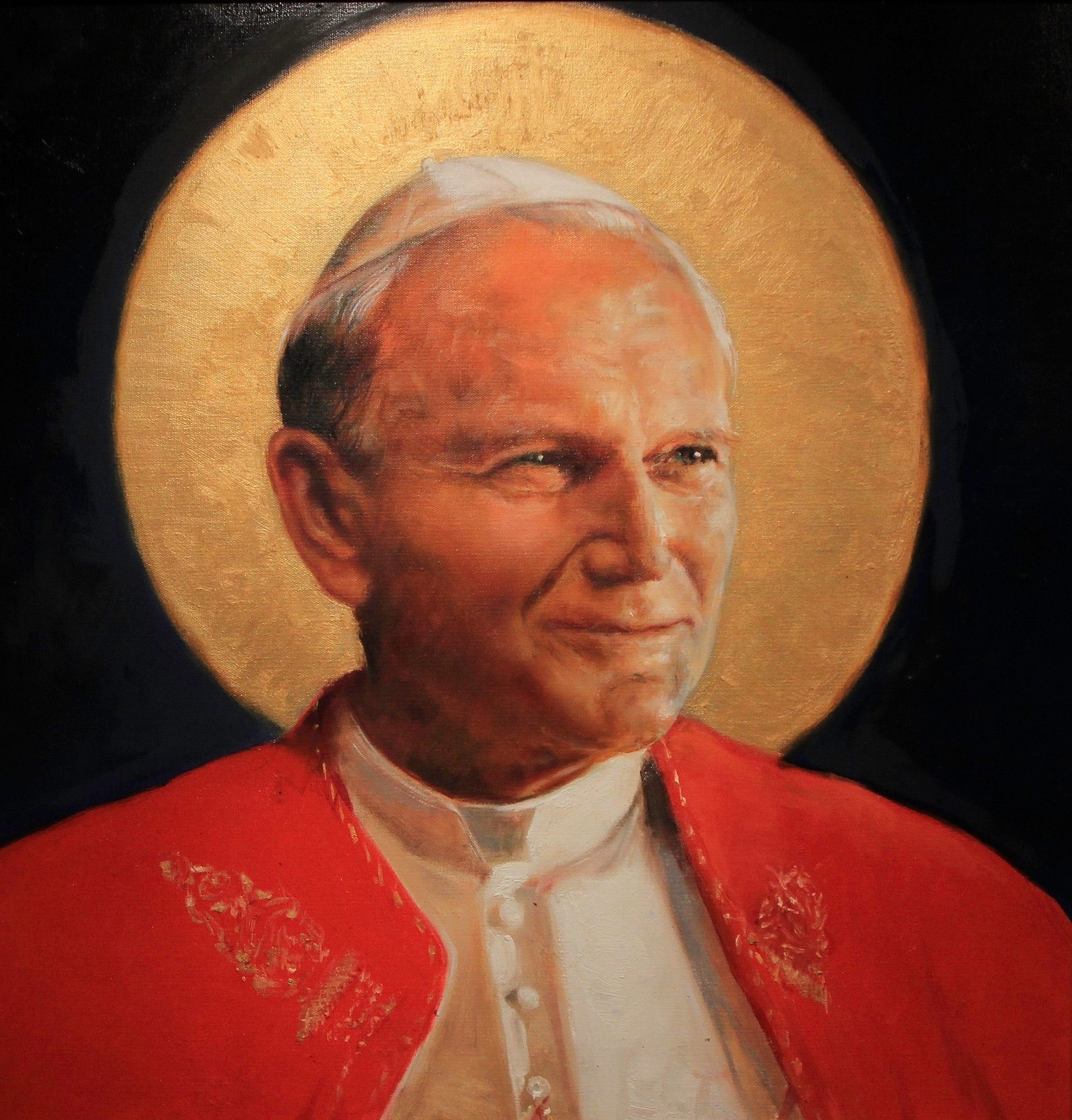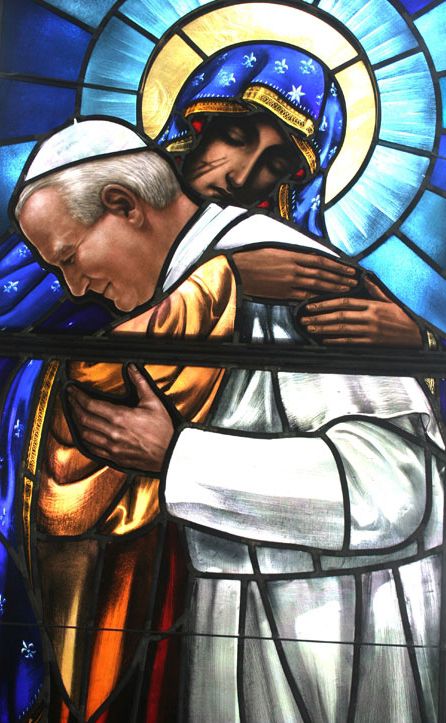The Church Urges the Faithful to Venerate Mary
Saint Pope John Paul II
T he Second Vatican Council exhorted the Church’s members to promote the various forms of Marian piety, especially liturgical devotion to Our Lady.
The veneration of the Virgin Mary was the subject of the Holy Father’s catechesis at the General Audience on Wednesday, 29 October 1997. Quoting the Second Vatican Council, the Pope urged that “the cult, especially the liturgical cult, of the Blessed Virgin, be generously fostered, and that the practices and exercises of devotion towards her, recommended by the teaching authority of the Church in the course of centuries, be highly esteemed.” Here is a translation of his catechesis, which was the 68th in the series on the Blessed Mother and was given in Italian.
1. After giving doctrinal justification to veneration of the Blessed Virgin, the Second Vatican Council exhorts all the faithful to promote it: “The Sacred Synod teaches this Catholic doctrine advisedly and at the same time admonishes all the sons of the Church that the cult, especially the liturgical cult, of the Blessed Virgin, be generously fostered, and that the practices and exercises of devotion towards her, recommended by the teaching authority of the Church in the course of centuries, be highly esteemed” (Lumen gentium, n. 67).
With this last statement the Council Fathers, without going into particulars, intended to reaffirm the validity of certain prayers such an the Rosary and the Angelus, dear to the tradition of the Christian people and frequently encouraged by the Supreme Pontiffs as an elective means of nourishing the life of faith and devotion to the Blessed Virgin.
Nicaea II Affirmed the Veneration of Sacred Images
2. The conciliar text goes on to ask believers “that those decrees, which were given in the early days regarding the veneration of images of Christ, the Blessed Virgin and the saints, be religiously observed“ (Lumen Gentium, n. 67). Thus it re-proposes the decisions of the Second Council of Nicaea, held in 787, which confirmed the legitimacy of the veneration of sacred images in opposition to those who wished to destroy them, since they considered them inadequate for representing the divinity (cf. Redemptoris Mater, n. 33).
“We define,” said the Fathers of that Council, “with full precision and care that, like the representation of the precious life-giving Cross, so the venerated and holy images either painted or mosaic or made of any other suitable material, should be exposed in holy churches of God on sacred furnishings and vestments, on walls and panels, in homes and streets, be they images of the Lord God and our Saviour Jesus Christ or of our immaculate Lady, the Holy Mother of God, of the holy angels, or of all the saints and the just” (DS 600). By recalling this definition, Lumen gentium intended to stress the legitimacy and validity of sacred images, in contrast to certain tendencies to remove them from churches and shrines in order to focus full attention on Christ.
3. The Second Council of Nicaea does not only affirm the legitimacy of images, but seeks to describe their usefulness for Christian piety: “Indeed, the more often these images are contemplated, the more those who look at them are brought to remember and desire the original models and, in kissing them, to show them respect and veneration” (DS 601}.
These directives apply in a particular way to the veneration of the Blessed Virgin. Images, icons and statues of Our Lady, present in houses, public places and countless churches and chapels, help the faithful to invoke her constant presence and her merciful patronage in the various circumstances of life. By making the Blessed Virgin’s motherly tenderness concrete and almost visible, they invite us to turn to her, to pray to her trustfully and to imitate her in generously accepting the divine will.
None of the known images is an authentic reproduction of Mary’s face, as St Augustine had already acknowledged (De Trinitate, 8,7); however they help us establish a more living relationship with her. Therefore the practice of exposing images of Mary in places of worship and in other buildings should be encouraged, in order to be aware of her help in moments of difficulty and as a reminder to lead a life that is ever more holy and faithful to God.
4. To encourage the proper use of sacred images, the Council of Nicaea recalls that “the honor paid to the image is really paid to the person it represents, and those who venerate the image are venerating the reality of the person it represents” (DS 601). Hence, in adoring the Person of the Incarnate Word in the image of Christ the faithful are making a genuine act of worship, which has nothing in common with idolatry. Similarly, when he venerates images of Mary, the believer’s act is ultimately intended as a tribute to the person of the Mother of Jesus.
5. Therefore, the Second Vatican Council urges theologians and preachers to refrain from both exaggerating and minimizing the special dignity of the Mother of God. It adds: “Following the study of Sacred Scripture, the Fathers, the doctors and liturgy of the Church, and under the guidance of the Church’s Magisterium, let them rightly illustrate the duties and privileges of the Blessed Virgin, which always refer to Christ, the source of all truth, sanctity and devotion” [Lumen gentium, n. 67).


The Church Urges the Faithful to Venerate Mary
In 1997, Pope John Paul II urges the faithful to venerate Mary. He discusses several councils in earlier Church history that discusses that icons and images are necessary to the faithful to venerate. That is the focus of this article.
Editors Note: On this website there is an audio that discusses a specific icon, the Mother of God with Three Hands. The story is about Fr. John of Damascus (who would later become a saint) and his devotion to Mary. What is important is how he was persecuted for writing that icons are not only acceptable in the Church, but is necessary. The Queen encourages all members to listen to Conference audio #1 using this link. Again, select Conference #1 I Am All Yours. The story of Fr. John begins at 4:30 in the timeline, but we encourage you to listen to the entire Conference #1 audio.
They aim above all at reaffirming authentic Marian devotion, which proceeds from faith and the loving recognition of Mary’s dignity, fosters filial affection for her and inspires the firm resolution to imitate her virtues.
Marian Devotion Stems From Faith and Filial Love
Authentic Marian doctrine is ensured by fidelity to Scripture and Tradition, as well as to the liturgical texts and the Magisterium. Its indispensable characteristic is the reference to Christ: everything in Mary derives from Christ and is directed to Him.
6. Lastly, the Council offers believers several criteria for authentically living their filial relationship with Mary: “Let the faithful remember moreover that true devotion consists neither in sterile nor transitory affection, nor in a certain vain credulity, but proceeds from true faith, by which we are led to recognize the excellence of the Mother of God, and we are moved to a filial love towards our Mother and to the imitation of her virtues” (Lumen gentium, n. 67).
With these words, the Council Fathers put people on guard against “vain credulity” and the predominance of sentiment. They aim above all at reaffirming authentic Marian devotion, which proceeds from faith and the loving recognition of Mary’s dignity, fosters filial affection for her and inspires the firm resolution to imitate her virtues.
VATICAN II AND TRUE DEVOTION TO MARY
Especially since the Council of Ephesus did the cult of God’s People toward Mary grow wondrously In veneration and love, in invocation and imitation. That was according to her own prophetic words: “All generations will call me blessed: for He who is mighty has done great things for me” (Luke 1:18- 19). This cult, as it has always existed in the Church, tough it is altogether singular, differs essentially from the cuIt of adoration, which is shown to the Incarnate Word equally with the Father and the Holy Spirit, and which the Malan cult promotes in a special way.
The Sacred Synod advisedly teaches this Catholic doctrine and at the same time admonishes all the Church’s children generously to foster the cult toward the Most Blessed Virgin, particularly the liturgical cult. Moreover, they should esteem highly practices and pious exercises toward her which have in the course of centuries been commended by the Magisterium; they should also religiously safeguard what has been decreed in bygone times about the cult of images of Christ and of the Blessed Virgin and of Saints.
Let the faithful be mindful that true devotion does not consist in sterile or passing emotion, nor in a certain empty credulity, but that it proceeds from true faith, by which we are led to acknowledge the excellence of God’s Mother, and are aroused to filial love toward her as our Mother and to the imitation of her virtues.
Constitution on Church, Ch. VIII, Nos. 66 and 67
Vol. #010 September 2021


